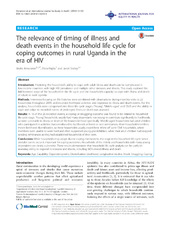| dc.contributor.author | Amurwon, Jovita | en_US |
| dc.contributor.author | Hajdu, Flora | en_US |
| dc.contributor.author | Seeley, Janet | en_US |
| dc.date.accessioned | 2016-06-21T09:36:13Z | |
| dc.date.available | 2016-06-21T09:36:13Z | |
| dc.date.issued | 2015-10-27 | |
| dc.Published | International Journal for Equity in Health. 2015 Oct 27;14(1):105 | eng |
| dc.identifier.uri | https://hdl.handle.net/1956/12150 | |
| dc.description.abstract | Introduction Predicting the household’s ability to cope with adult illness and death can be complicated in low-income countries with high HIV prevalence and multiple other stressors and shocks. This study explored the link between stage of the household in the life cycle and the household’s capacity to cope with illness and death of adults in rural Uganda. Methods Interviews focusing on life histories were combined with observations during monthly visits to 22 households throughout 2009, and recorded livelihood activities and responses to illness and death events. For the analysis, households were categorised into three life cycle stages (‘Young’, ‘Middle-aged’ and ‘Old’) and the ability to cope and adapt to recorded events of prolonged illness or death was assessed. Results In 16 of the 26 recorded events, a coping or struggling outcome was found to be related to household life cycle stage. ‘Young’ households usually had many dependants too young to contribute significantly to livelihoods, so were vulnerable to illness or death of the household head specifically. ‘Middle-aged’ households had adult children who participated in activities that contributed to livelihoods at home or sent remittances. More household members meant livelihood diversification, so these households usually coped best. Worst off were ‘Old’ households, where members were unable to work hard and often supported young grandchildren, while their adult children had stopped sending remittances as they had established households of their own. Conclusions While households may adopt diverse coping mechanisms, the stage in the household life cycle when stressful events occur is important for coping outcomes. Households of the elderly and households with many young dependents are clearly vulnerable. These results demonstrate that household life cycle analysis can be useful in assessing ability to respond to stressors and shocks, including AIDS-related illness and death. | en_US |
| dc.language.iso | eng | eng |
| dc.publisher | BioMed Central | eng |
| dc.rights | Attribution CC BY 4.0 | eng |
| dc.rights.uri | http://creativecommons.org/licenses/by/4.0 | eng |
| dc.subject | Age | eng |
| dc.subject | Capability | eng |
| dc.subject | Dependency-ratio | eng |
| dc.subject | Diversification | eng |
| dc.subject | Livelihood | eng |
| dc.subject | Longitudinal studies | eng |
| dc.subject | Shock | eng |
| dc.subject | Struggling | eng |
| dc.subject | Coping | eng |
| dc.title | The relevance of timing of illness and death events in the household life cycle for coping outcomes in rural Uganda in the era of HIV | en_US |
| dc.type | Peer reviewed | |
| dc.type | Journal article | |
| dc.date.updated | 2015-11-18T15:05:55Z | |
| dc.description.version | publishedVersion | en_US |
| dc.rights.holder | Copyright Amurwon et al. 2015 | |
| dc.identifier.doi | https://doi.org/10.1186/s12939-015-0253-0 | |
| dc.subject.nsi | VDP::Medisinske Fag: 700 | en_US |

